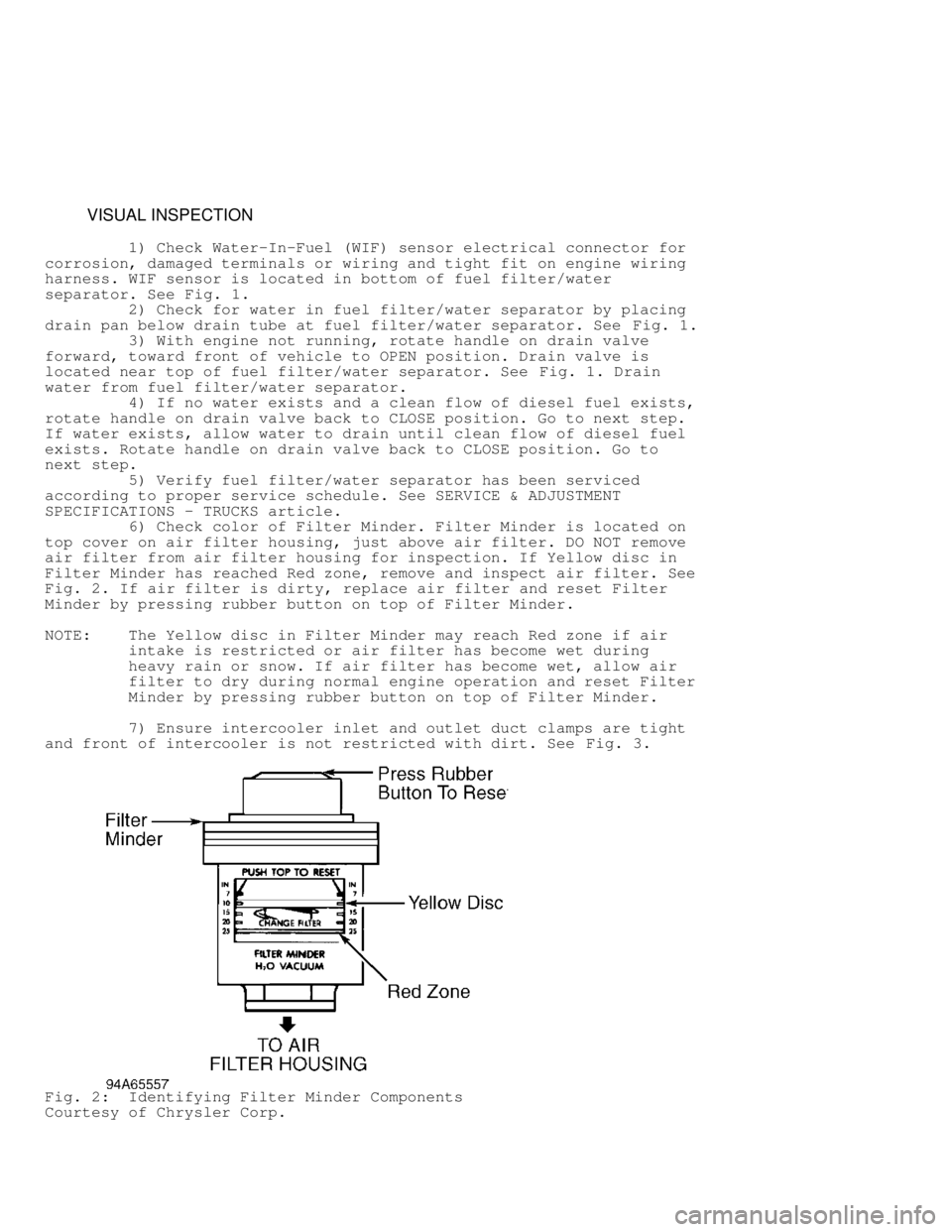1999 DODGE RAM reset
[x] Cancel search: resetPage 269 of 1691

article in ENGINE PERFORMANCE for diagnosis by symptom. If initial
symptom no longer exists, test is complete. Go to step 6).
2) If PCM has not been replaced, and TEST VER-2A (DIESEL) is\
being performed after a DTC test, inspect vehicle to ensure all engine
components are connected. Reassemble and reconnect components as
necessary. Using scan tool, erase DTCs, reset all memory values and go
to step 4).
3) If PCM has not been replaced, and TEST VER-2A (DIESEL) is\
being performed after an A/C relay control circuit DTC test, ensure
A/C is on and go to next step.
4) Road test vehicle for at least 5 minutes. Road test
vehicle at a speed of at least 40 MPH at some point during road test.
Stop vehicle. Turn engine off for at least 10 seconds. Start engine
and continue road test. Ensure transmission shifts through all gears.
After road test, turn engine off and go to next step.
5) Using scan tool, read DTCs. If any DTC returns, perform
appropriate test(s). If no DTCs return, test is complete. Go to next
step.
6) Turn ignition on, with engine off. Using scan tool, erase
DTCs. Turn ignition off. Disconnect scan tool. Test is complete.
TEST VER-5A (EXCEPT DIESEL)
NOTE: If Powertrain Control Module (PCM) is replaced, correct
vehicle mileage and Vehicle Identification Number (VIN) must
be programmed into PCM to prevent Diagnostic Trouble Codes
(DTCs) from being set in Anti-Lock Brake System (ABS) modul\
e
and Supplemental Restraint System (SRS) module. To program
PCM and clear DTCs from ABS and SRS modules, proceed to
appropriate procedure listed below. On models equipped with a
Smart Key Immobilizer Module (SKIM), if replacing Powertrain
Control Module (PCM), secret key data must also be updated to\
enable engine starting. To update secret key data, proceed to
appropriate procedure listed below.
Procedure For Programming PCM & Clearing DTCs From ABS & SRS
Modules
Connect scan tool to Data Link Connector (DLC). Using scan
tool, enter correct VIN and mileage into PCM. Using scan tool
manufacturer's instructions, clear DTCs from ABS and SRS modules. Go
to step 1)).
Procedure For Updating Secret Key Data
Connect scan tool to Data Link Connector (DLC). Go to ENGINE
and then MISC menus on scan tool. Place SKIM in SECURED ACCESS MODE by
using appropriate Personal Identification Number (PIN) for this
vehicle. PIN may be obtained from owner, vehicle's invoice, or from
manufacturer. Select UPDATE THE SECRET KEY DATA. Data will be
transferred from Smart Key Immobilizer Module (SKIM) to PCM. Go to
step 1)).
1) Inspect vehicle to ensure all engine components are
connected. Reassemble and reconnect components as necessary. If any
DTCs have not been diagnosed, return to appropriate test(s). If all
DTCs have been diagnosed and repaired, go to next step.
2) Connect scan tool to Data Link Connector (DLC) if not
previously done. Ensure fuel tank is at least 1/4 full. Ensure A/C is
off. Go to next step.
3) Proper way to ensure DTC is repaired is to allow
Powertrain Control Module (PCM) to run monitor. Monitor operation may
be observed on scan tool. All specified enabling conditions for
specified DTC must be met before PCM will operate monitor. Go to next
step.
Page 270 of 1691

4) Using scan tool, monitor pretest enabling conditions until
all conditions have been met. Once all enabling conditions are met,
observe appropriate monitor for DTC on scan tool. If repaired DTC has
reset or is seen on monitor while on road test, repair is not
complete. Check for related Technical Service Bulletins (TSBs) and
return to appropriate test. If no DTCs return, test is complete. Go to
step 6).
5) If another DTC exists, return to appropriate test(s). If
no DTCs return, test is complete. Go to next step.
6) Turn ignition on, with engine off. Using scan tool, erase
DTCs. Turn ignition off. Disconnect scan tool. Test is complete.
TEST VER-5A (DIESEL)
NOTE: If Accelerator Pedal Position Sensor (APPS), battery, Engine
Control Module (ECM) or Powertrain Control Module (PCM) has\
been disconnected or replaced, APPS must be reprogrammed and
correct vehicle mileage and Vehicle Identification Number
(VIN) must be programmed into PCM to prevent Diagnostic
Trouble Codes (DTCs) from being set in Anti-Lock Brake System\
(ABS) module and Supplemental Restraint System (SRS) module\
.
To program PCM and clear DTCs from ABS and SRS modules,
proceed to appropriate procedure listed below. On models
equipped with a Smart Key Immobilizer Module (SKIM), if
replacing Powertrain Control Module (PCM), secret key data
must also be updated to enable engine starting. To update
secret key data, proceed to appropriate procedure listed
below.
CAUTION: DO NOT attempt to adjust screws or disassemble APPS. Settings
are preset at factory and are not intended to by changed.
Procedure For Programming APPS
Reassemble all components. Turn ignition switch to ON or RUN
position without starting engine. Slowly press accelerator pedal to
floor once and slowly release. This procedure programs APPS
calibration in ECM. Go to step 1)).
Procedure For Programming PCM & Clearing DTCs From ABS & SRS
Modules
Connect scan tool to Data Link Connector (DLC). Using scan
tool, enter correct VIN and mileage into PCM. Using scan tool
manufacturer's instructions, clear DTCs from ABS and SRS modules. Go
to step 1)).
Procedure For Updating Secret Key Data
Connect scan tool to Data Link Connector (DLC). Go to ENGINE
and then MISC menus on scan tool. Place SKIM in SECURED ACCESS MODE by
using appropriate Personal Identification Number (PIN) for this
vehicle. PIN may be obtained from owner, vehicle's invoice, or from
manufacturer. Select UPDATE THE SECRET KEY DATA. Data will be
transferred from Smart Key Immobilizer Module (SKIM) to PCM. Go to
step 1)).
1) If PCM has not been replaced, inspect vehicle to ensure
all engine components are connected. Reassemble and reconnect
components as necessary. If any DTCs have not been diagnosed, return
to appropriate test(s). If all DTCs have been diagnosed and repaired,
go to next step.
2) Ensure fuel tank is at least 1/4 full. Ensure A/C is off.
Proper way to ensure DTC is repaired is to connect scan tool to Data
Link Connector (DLC) and allow Powertrain Control Module (PCM) to ru\
n
a DTC SPECIFIC GOOD TRIP COUNTER for 2 minutes. If DTC SPECIFIC GOOD
Page 283 of 1691

VISUAL INSPECTION
1) Check Water-In-Fuel (WIF) sensor electrical connector for\
corrosion, damaged terminals or wiring and tight fit on engine wiring
harness. WIF sensor is located in bottom of fuel filter/water
separator. See Fig. 1.
2) Check for water in fuel filter/water separator by placing
drain pan below drain tube at fuel filter/water separator. See Fig. 1.
3) With engine not running, rotate handle on drain valve
forward, toward front of vehicle to OPEN position. Drain valve is
located near top of fuel filter/water separator. See Fig. 1. Drain
water from fuel filter/water separator.
4) If no water exists and a clean flow of diesel fuel exists,
rotate handle on drain valve back to CLOSE position. Go to next step.
If water exists, allow water to drain until clean flow of diesel fuel
exists. Rotate handle on drain valve back to CLOSE position. Go to
next step.
5) Verify fuel filter/water separator has been serviced
according to proper service schedule. See SERVICE & ADJUSTMENT
SPECIFICATIONS - TRUCKS article.
6) Check color of Filter Minder. Filter Minder is located on
top cover on air filter housing, just above air filter. DO NOT remove
air filter from air filter housing for inspection. If Yellow disc in
Filter Minder has reached Red zone, remove and inspect air filter. See
Fig. 2 . If air filter is dirty, replace air filter and reset Filter
Minder by pressing rubber button on top of Filter Minder.
NOTE: The Yellow disc in Filter Minder may reach Red zone if air
intake is restricted or air filter has become wet during
heavy rain or snow. If air filter has become wet, allow air
filter to dry during normal engine operation and reset Filter
Minder by pressing rubber button on top of Filter Minder.
7) Ensure intercooler inlet and outlet duct clamps are tight
and front of intercooler is not restricted with dirt. See Fig. 3.
Fig. 2: Identifying Filter Minder Components
Courtesy of Chrysler Corp.
Page 304 of 1691

PCM INACTIVE ON BUS, go to appropriate VEHICLE COMMUNICATIONS article.
If scan tool does not display PCM INACTIVE ON BUS, go to next step.
4) Turn ignition off. Remove instrument cluster. See
appropriate INSTRUMENT PANELS article. Turn ignition on. Using
external voltmeter, measure voltage between ground and instrument
cluster connector C1 terminal No. 6 (Yellow wire). If voltage is 10
volts or less, repair open Yellow wire. If voltage is more than 10
volts, replace instrument cluster.
ANY CCD CLUSTER LIGHT INOPERATIVE
NOTE: For connector terminal identification and wiring diagrams,
see BODY CONTROL COMPUTER - INTRODUCTION article. Perform
VERIFICATION TEST VER-1A after each repair.
CAUTION: Always turn ignition switch to OFF position prior to
disconnecting or connecting any module connector.
1) Turn ignition on. Using scan tool, select ELECTRO/MECH
CLUSTER. If scan tool displays BUS OPERATIONAL, go to next step. If
scan tool does not display BUS OPERATIONAL, go to appropriate VEHICLE
COMMUNICATIONS article and follow appropriate symptom diagnostics.
2) If scan tool displays NO RESPONSE, go to appropriate
VEHICLE COMMUNICATIONS article. If scan tool does not display NO
RESPONSE, go to next step.
3) Using scan tool, select SYSTEM TEST. If scan tool displays
PCM INACTIVE ON BUS, go to appropriate VEHICLE COMMUNICATIONS article.
If scan tool does not display PCM INACTIVE ON BUS, go to next step.
4) Push and hold RESET button while cycling ignition key.
Release RESET button when CHEC appears in odometer display. Observe
inoperative light during self-test. If inoperative light did not
illuminate during self-test, go to next step. If inoperative light
illuminated during self-test, verify if light is controlled by an
input to instrument cluster. See appropriate wiring diagram in BODY
CONTROL COMPUTER - INTRODUCTION article. If light is controlled by an
input to instrument cluster, go to appropriate circuits article or
symptom test. See IDENTIFYING VEHICLE EQUIPMENT & SYSTEM PROBLEMS. If
light is not controlled by an input to instrument cluster, system is
currently functioning correctly.
5) Gain access to instrument cluster. See appropriate
INSTRUMENT PANELS article. If defective light is a LED, replace
instrument cluster. If defective light is a bulb, go to next step.
6) Remove and inspect defective bulb. If bulb is burned out,
replace bulb. If bulb is not burned out, replace instrument cluster.
ANY HARD WIRED CLUSTER WARNING LIGHT INOPERATIVE
NOTE: For connector terminal identification and wiring diagrams,
see BODY CONTROL COMPUTER - INTRODUCTION article. Perform
VERIFICATION TEST VER-1A after each repair.
CAUTION: Always turn ignition switch to OFF position prior to
disconnecting or connecting any module connector.
1) Remove instrument cluster. See appropriate INSTRUMENT
PANELS article. Remove inoperative bulb. If bulb is burned out,
replace bulb. If bulb is not burned out, go to next step.
2) Inspect wiring diagram and evaluate which instrument
cluster provides; power or ground for inoperative bulb. See
appropriate wiring diagram in BODY CONTROL COMPUTER - INTRODUCTION
article. Using external ohmmeter or voltmeter, check appropriate power
or ground circuit. If circuit is okay, replace instrument cluster. If
power or ground is not available at appropriate circuit, repair open
Page 305 of 1691

circuit.
ONE GAUGE NOT OPERATING PROPERLY
NOTE: For connector terminal identification and wiring diagrams,
see BODY CONTROL COMPUTER - INTRODUCTION article. Perform
VERIFICATION TEST VER-1A after each repair.
CAUTION: Always turn ignition switch to OFF position prior to
disconnecting or connecting any module connector.
1) Push and hold RESET button while cycling ignition key; ON-
OFF-ON. Instrument cluster self-test will start. If inoperative gauge
reached proper calibration point, go to next step. If inoperative
gauge did not reach proper calibration point, replace instrument
cluster.
2) Stop instrument cluster self-test. If problem is with
speedometer, go to next step. If problem is with oil pressure gauge,
go to step 5). If problem is with temperature gauge, go to step 14).
If problem is with fuel level gauge, go to appropriate SELF-
DIAGNOSTICS article in ENGINE PERFORMANCE section and review
powertrain symptoms. If problem is with volt gauge, go to step 16). If
problem is with tachometer, go to step 18).
3) Using scan tool, select BODY, SYSTEMS TESTS then PCM
MONITOR. If scan tool displays PCM ACTIVE ON BUS, go to next step. If
scan tool does not display PCM ACTIVE ON BUS, go to appropriate
VEHICLE COMMUNICATIONS article.
4) Raise and support all wheels. Start engine and place gear
selector in drive. Using scan tool, select MIC, MONITORS then CCD BUS
ENGINE INFO. Read VSS. If vehicle speed on scan tool matches
speedometer, see appropriate ANTI-LOCK BRAKE article. If vehicle speed
on scan tool does not match speedometer, replace instrument cluster
circuit board.
5) Turn ignition on. If CHECK GAUGES light illuminated, go to
next step. If CHECK GAUGES light did not illuminate, go to step 11).
6) Turn ignition off. Inspect oil level. If oil level is
within specification, go to next step. If oil level is not within
specification, adjust oil level and retest.
7) Turn ignition on. Disconnect engine Oil Pressure Switch
(OPS) connector. OPS is located near bottom of distributor. If CHECK
GAUGES light went out, go to next step. If CHECK GAUGES light did not
go out, go to step 10).
8) Remove OPS. Connect mechanical oil pressure gauge to OPS
port. Start engine. If engine oil pressure at idle is 4 psi or more,
go to next step. If engine oil pressure at idle is less than 4 psi,
repair mechanical engine problem.
9) Run engine to reach normal operating temperature. If
engine oil pressure at idle is 4 psi or more, replace OPS. If engine
oil pressure at idle is less than 4 psi, repair mechanical engine
problem.
10) Turn ignition off. Disconnect PCM White connector C2. PCM
is located in engine compartment on right inner fender. Using an
external ohmmeter, measure resistance between ground and PCM Black
connector terminal No. 23 (Gray/Orange wire). If resistance is less
than 5 ohms, repair short to ground in Gray/Orange wire. If resistance
is 5 ohms or more, replace PCM.
11) Disconnect engine Oil Pressure Switch (OPS) connector.
OPS is located near bottom of distributor. Using an external ohmmeter,
measure resistance between ground and OPS connector Black/Light Blue
wire. If resistance is less than 5 ohms, go to next step. If
resistance is 5 ohms or more, repair open Black/Light Blue wire.
Black/Light Blue wire is a common sensor ground. If no other engine
sensors are failed, repair ground between sensor and splice. If
Page 401 of 1691

10) Depress and release CANCEL switch. If S/C disengages, go
to next step. If S/C did not disengage, repair is not complete. Check
for related TSBs and return to TROUBLE SHOOTING, if necessary.
11) Ensure vehicle speed is greater than 35 MPH. Engage speed
control. Turn S/C on/off switch to OFF position. If speed control
disengages, system is operating correctly. Repair is complete. If
speed control does not disengage, repair is not complete. Check for
related TSBs and return to TROUBLE SHOOTING, if necessary.
TEST VER-5A
NOTE: If PCM has been replaced and correct VIN and mileage have not
been programmed, a FTC will be set in ABS and air bag
modules. If vehicle is equipped with a Sentry Key Immobilizer
Module (SKIM), sentry key data must be updated to enable
starting. See COMPUTER RELEARN PROCEDURES article in GENERAL
INFORMATION.
1) If vehicle is not equipped with a diesel engine, go to
next step. If vehicle is equipped with a diesel engine, and PCM has
been disconnected or replaced, battery has been disconnected, or
Accelerator Pedal Position Sensor (APPS) has been disconnected or
replaced, APPS calibration must be programmed into PCM (diesel only).
Turn ignition on. Slowly press accelerator pedal to floor and slowly
release. DO NOT attempt to adjust screws or disassemble APPS. Go to
next step.
2) On all engines, if vehicle is equipped with ABS or air
bag, enter correct VIN and mileage in PCM. Erase DTCs in ABS and air
bag modules. Inspect vehicle to ensure all engine and speed control
system components are connected.
3) If there are any DTCs that have not been repaired, go to
SELF-DIAGNOSTIC SYSTEM. After all DTCs have been repaired, run
appropriate monitor for previously repaired FTC.
4) Connect scan tool to DLC. Ensure fuel tank is at least 1/4
full. Turn off all accessories. Allow PCM to run appropriate monitor
and increment appropriate good trip. Enabling conditions must be met
before monitor will run.
5) Using scan tool, monitor pretest enabling conditions until
all conditions have been met. Once enabling conditions have been met,
monitor appropriate monitor.
6) If repaired FTC has reset or was seen in monitor while on
road test, repair is not complete. Check for TSBs or flash updates and
return to TROUBLE SHOOTING.
7) If appropriate monitor ran, good trip counter incremented
and no DTCs have been set, repair is complete.
REMOVAL & INSTALLATION
WARNING: Vehicle is equipped with an air bag. Air bag must be
deactivated before servicing speed control components on or
around steering column. See AIR BAG RESTRAINT SYSTEMS -
TRUCKS article.
CAUTION: When battery is disconnected, vehicle computer and memory
systems may lose memory data. Driveability problems may exist
until computer systems have completed a relearn cycle. See
COMPUTER RELEARN PROCEDURES article in GENERAL INFORMATION
before disconnecting battery.
BRAKE SWITCH
Removal
Page 402 of 1691

Fully depress brake pedal and rotate brake switch
counterclockwise approximately 30 degrees. Remove brake switch from
bracket. Depress lock tabs holding brake switch mounting bracket and
separate harness connector from brake switch.
Installation
1) Before installing brake switch, reset adjustable plunger
by pulling on plunger head until plunger reaches end of travel.
Connect harness connector to brake switch. Depress brake pedal and
insert brake switch into keyed hole in mounting bracket. Rotate brake
switch clockwise into locked position.
2) Gently pull back on brake pedal until pedal will go no
further. This causes the brake switch plunger to ratchet backward to
the correct position. No further adjustment is required.
SPEED CONTROL SERVO
Removal (Except Ram Van & Ram Wagon)
1) Disconnect negative battery cable. Disconnect electrical
connector and vacuum hose from servo. Using finger pressure only, push
servo cable connector from throttle body bellcrank pin. DO NOT pull
cable connector perpendicular to bellcrank.
2) Remove 2 servo cable mounting nuts. Pull servo cable
sleeve away from mounting bracket to expose cable retaining clip.
Remove retaining clip. Remove servo.
Removal (Ram Van & Ram Wagon)
1) Disconnect negative battery cable. Remove engine cover.
Remove air cleaner assembly. Using finger pressure only, push servo
cable connector from throttle body bellcrank pin. DO NOT pull cable
connector perpendicular to bellcrank.
2) Remove right headlight assembly. Disconnect vacuum hose
and electrical connector at servo. Remove 2 servo mounting bracket
bolts. Remove 2 servo cable mounting nuts. Pull servo cable sleeve
away from mounting bracket to expose cable retaining clip. Remove
retaining clip. Remove servo.
Installation (All Models)
With throttle in full open position, align hole in speed
control cable sleeve with hole in servo pin. Install retaining clip.
To complete installation, reverse removal procedure. Tighten mounting
bolts/nuts to 75 INCH lbs. (8.5 N.m).
SPEED CONTROL SWITCHES
Removal & Installation
Turn ignition off. Disconnect negative battery cable. Wait 2
minutes for air bag system to discharge reserve voltage. Remove 2
screws holding air bag assembly to steering column. Separate air bag
assembly from steering column and disconnect air bag, horn and speed
control switch connectors. Remove screws securing speed control switch
to air bag assembly. Separate speed control switch from air bag
assembly. To install, reverse removal procedure.
WIRING DIAGRAMS
Page 616 of 1691

If equipped, the EMR light (some models may use a reminder
flag) reminds vehicle operator that an emission system maintenance is
required. This indicator is activated after a predetermined
time/mileage.
When performing a smog check inspection, ensure EMR indicator
is not activated. On models using an EMR light, light should glow when
ignition switch is turned to ON position and should turn off when
engine is running.
If an EMR flag is present or an EMR light stays on with
engine running, fail vehicle and service or replace applicable
emission-related components. To reset an EMR indicator, refer to
appropriate MAINTENANCE REMINDER LIGHTS in the MAINTENANCE section.
MALFUNCTION INDICATOR LIGHT (MIL)
The Malfunction Indicator Light (MIL) is used to alert
vehicle operator that the computerized engine control system has
detected a malfunction (when it stays on all the time with engine
running). On some models, the MIL may also be used to display trouble
codes.
As a bulb and system check, malfunction indicator light will
glow when ignition switch is turned to ON position and engine is not
running. When engine is started, light should go out.